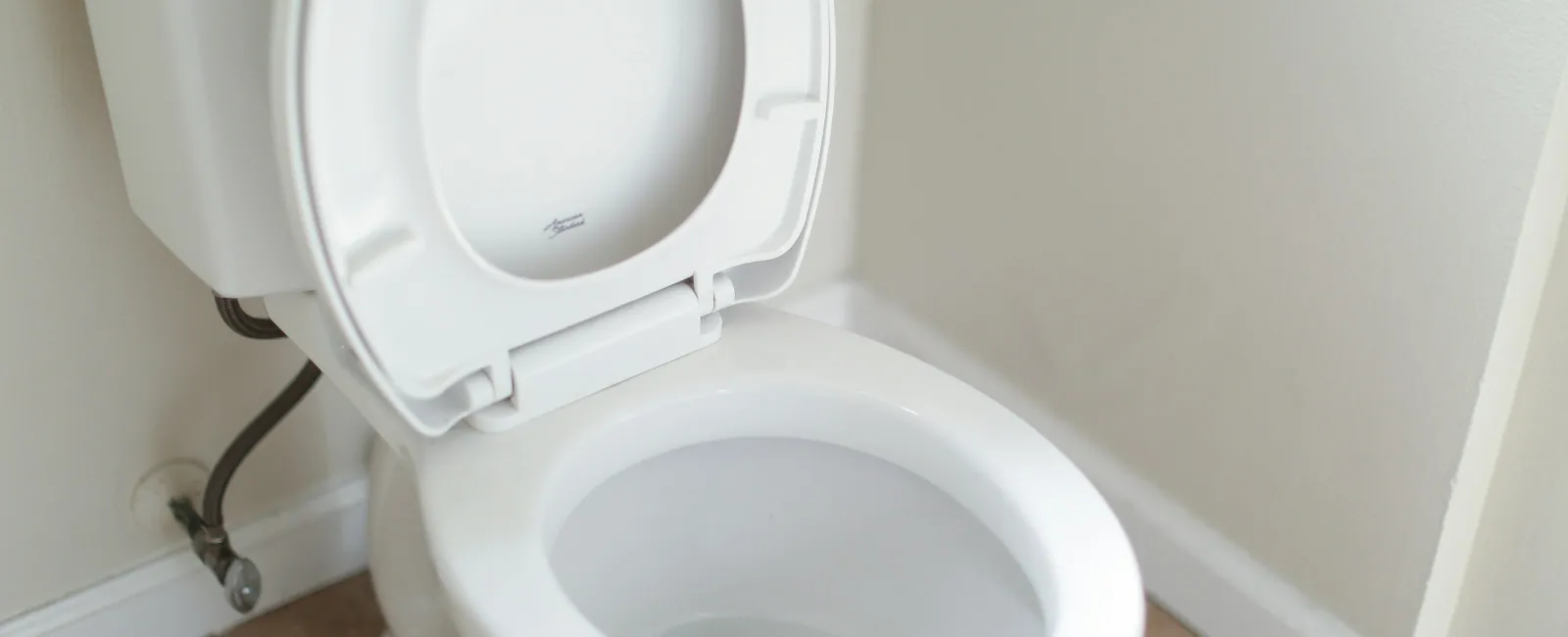November 06, 2025
A running toilet wastes up to 200 gallons of water per day. That's 6,000 gallons per month flowing straight down the drain. If your water bill has been climbing for no apparent reason, a constantly running toilet is usually the culprit.
At Total Mechanical Care, we've been helping families fix toilet problems for generations. Most people believe that a running toilet indicates the need to replace the flapper. While that's sometimes true, four other common causes get overlooked. Let's walk through all five reasons your toilet keeps running and what you can do about each one.
1. Worn-Out Flapper Valve
The flapper sits at the bottom of your tank, creating a watertight seal. When you flush, it lifts to release water, then settles back down. Over time, this rubber component deteriorates due to constant exposure to water and chemicals.
A worn flapper doesn't seal properly. Water slowly leaks from the tank to the bowl. Your fill valve senses the dropping water level and keeps refilling the tank, creating an endless cycle.
Signs your flapper is the problem:
- The flapper feels slimy, brittle, or has visible cracks
- Adding food coloring to the tank shows colored water in the bowl without flushing
- Running stops temporarily when you push down on the flapper
How to fix it: Turn off the water supply behind your toilet. Flush to empty the tank. Remove the old flapper by unhooking it from the overflow tube. Install the new flapper and adjust the chain so it has just a little slack when closed. A chain that's too tight prevents proper sealing. Too loose and it gets caught under the flapper.
If you've replaced the flapper and your toilet still runs constantly, the problem lies elsewhere. This is when professional toilet repair services can quickly diagnose the real issue.
2. Malfunctioning Fill Valve
The fill valve controls the flow of water into your tank after each flush. When it malfunctions, water continues to flow even after the tank is full. You'll often hear a constant hissing sound or see water trickling into the overflow tube.
Fill valves fail when mineral deposits build up inside, the internal seal wears out, or debris gets lodged in the mechanism. Hard water accelerates this wear.
Signs your fill valve is failing:
- A constant hissing sound from the tank
- Water running directly into the overflow tube
- The tank takes an unusually long time to fill
How to fix it: First, try cleaning the valve. Shut off the water and flush the toilet. Remove the cap from the fill valve by turning counterclockwise. Hold a cup upside down over the valve and briefly turn the water back on to flush out any debris. If cleaning doesn't work, the fill valve needs to be replaced.
Replacing a fill valve requires shutting off water, draining the tank, disconnecting the supply line, and installing the new valve at the correct height. If you're not comfortable with these steps, professional toilet repair ensures the job is done right the first time.
3. Incorrectly Adjusted Float
The float tells your fill valve when to stop adding water. If set too high, water rises above the proper level and spills into the overflow tube. This creates continuous running as the fill valve works to maintain the too-high water level.
Older toilets use a ball float on a metal arm that can bend upward over time, allowing the float to become less effective. Newer toilets use a float cup that slides up and down the fill valve. The adjustment screw may have become loose or may have been set incorrectly during a previous repair.
Signs your float needs adjustment:
- The water level in the tank is within an inch of the top
- You see water flowing into the overflow tube
- Running stops when you manually push the float down
How to fix it: For ball float systems, gently bend the metal arm downward. The water level should stop about one inch below the top of the overflow tube. For float cup systems, find the adjustment screw or clip on the fill valve and turn or move it to lower the float. Make small adjustments and test after each change.
4. Mispositioned Refill Tube
The refill tube is a small, flexible tube that runs from your fill valve to the overflow tube. It adds water back into the bowl after flushing. If positioned incorrectly, it creates a siphoning effect that causes continuous running.
The most common problem happens when the refill tube extends too far down into the overflow tube. Water flowing through creates a suction that pulls water from the tank, and this siphoning action continues indefinitely.
How to fix it: Pull the refill tube out of the overflow tube. The end should sit just above the rim of the overflow tube, not inside it. If the tube is too long, trim it with scissors. Some toilets include a small clip that attaches the tube to the side of the overflow tube at the correct height.
This is one of the simplest fixes for a running toilet, but it often gets overlooked because the refill tube is small and easy to miss.
5. Faulty Flush Handle Assembly
The flush handle connects to a lever arm inside the tank that lifts the flapper via the chain. When the handle assembly fails, it can prevent the flapper from sealing properly or create tension that keeps the flapper slightly raised.
Problems can develop when the handle becomes loose and wobbly, mineral deposits cause it to stick in the pressed position, or the internal lever cracks. Sometimes the handle just wears out after thousands of flushes.
Signs your flush handle is causing problems:
- The handle feels loose or sticks in the down position
- You need to hold the handle down for complete flushing
- Running stops when you wiggle the handle
How to fix it: Try tightening the mounting nut inside the tank first. This nut has reverse threads, so turn it clockwise to tighten. If the handle still sticks or feels loose, replace it. Remove the old handle by loosening the mounting nut, disconnecting the chain, and pulling the assembly out. Install the new handle and reconnect the chain with proper slack.
When to Call a Professional
You've checked the flapper, inspected the fill valve, adjusted the float, repositioned the refill tube, and examined the handle. Everything looks fine, but your toilet still won't stop running.
Sometimes running toilets have multiple problems at once. Other times, the issue isn't with standard components. Cracks in the tank or bowl cause slow leaks. The overflow tube itself can crack. Sediment buildup affects multiple components.
Call a professional if:
- You've tried all five fixes, and the toilet still runs
- You find cracks in the tank or overflow tube
- Water pools around the base of the toilet
- Multiple toilets in your home are having problems
- You're not comfortable working inside the toilet tank
A running toilet can waste up to 6,000 gallons of water per month. At average water rates, that adds roughly $9 to your monthly bill, or over $100 per year. Professional toilet repair typically costs less than a year's worth of wasted water and pays for itself quickly.
Preventing Future Problems
Once you've fixed your running toilet, these maintenance habits prevent future issues:
Inspect regularly: Remove your tank lid every few months and watch a complete flush cycle. Make sure the flapper seals properly, the fill valve shuts off when full, and all components move freely.
Address hard water: Hard water accelerates wear on toilet components. Mineral deposits build up faster, and seals deteriorate more quickly. Consider a water softener if you have hard water.
Skip tank tablets: Those blue cleaning tablets that sit in your tank are harsh on rubber components. They break down flappers and seals faster. Clean your bowl with a brush and standard cleaner instead.
Replace parts proactively: Flappers typically need replacement every 3 to 5 years. Fill valves last longer but should be replaced after 7 to 10 years. Replacing parts before they fail completely prevents water waste.
Get Expert Help When You Need It
At Total Mechanical Care, we believe that homeowners should understand how their plumbing systems work. These five fixes address the majority of running toilet issues. But we also know plumbing repairs can be tricky, and not everyone feels comfortable taking apart their toilet tank.
Our licensed plumbers handle everything from simple repairs to complete toilet replacement. We diagnose the exact cause of your running toilet, clearly explain your options, and fix the problem the first time.
Every job is guided by integrity, craftsmanship, and a commitment to getting it done right. We provide flat-rate pricing with no surprises, no hidden fees, and no last-minute markups. You get a detailed estimate before any work begins, and we back every job with our 100% satisfaction guarantee.
Don't let a running toilet waste thousands of gallons and drain your wallet. Contact us at Total Mechanical Care. Our toilet repair team is available 24/7 for plumbing emergencies because toilet problems don't wait for business hours.
Need Professional Toilet Repair?
Our licensed plumbers quickly and correctly fix running toilets. We arrive on time, accurately diagnose the problem, and restore your peace and quiet. Serving Cumming, Alpharetta, Roswell, and surrounding communities. Contact us for expert toilet repair.




